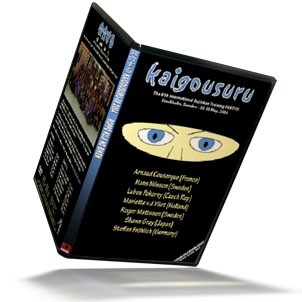Kaigousuru 8 -- the eighth International Bujinkan Training Party with…
- Arnaud Cousergue
- Steffen Fröhlich
- Mariette van der Vliet
- Lubos Pokorny
- Shawn Gray
- Hans Nilsson
- Roger Mattsson
- Mats Hjelm
Theme was Roppo kuji no biken, Sword, taijutsu basics, advanced taijutsu and much more
Recorded in Stockholm, Sweden May 2004
Friday training
Session 1; Shawn taught Taijutsu and Sword. Session 2; Roger taught sword. Session 3; Arnaud taught the nine Kenjutsu techniques from Kukishin-ryu, then he explained how to hold the sword and how to cut.
Saturday training
Session 1; Steffen taught Taijutsu and sword. Session 2; Hasse taught Taijutsu and sword. Session 3; Henka chain with all the instructors. Session 4; Mariette taught Taijutsu and knife fighting.
Sunday training
Session 1; Carl Holmes taught backflips. Session 2; All the instructors taught Sanshin no kata. Session 3; Lubos taught Taijutsu and sword. Session 3; Henka chain with all the instructors. Session 4; Question and answers.
The theme of this year was Roppo Kuji no Biken. All of the instructors had already been in Japan this year and got the feeling of this years theme.
There was also a Q&A session, where the instructors talked about this years theme and much more.
Sample clip from the video
www.youtube.com/watch?v=0ymZM3_Wnm0
About the download
Click here for more information about our download files and how it works!…
Read More





 But when it comes to the training we have to keep in mind that Japanese people before the 20th century were not tall (often around 150 cm). So, for us westerners, in order to keep the same ratio size/length in the buki waza (武器), our long staff should have a length of at least 2m. Note that buki (技) means also technique or art…
But when it comes to the training we have to keep in mind that Japanese people before the 20th century were not tall (often around 150 cm). So, for us westerners, in order to keep the same ratio size/length in the buki waza (武器), our long staff should have a length of at least 2m. Note that buki (技) means also technique or art…
